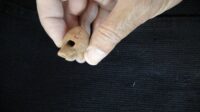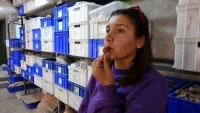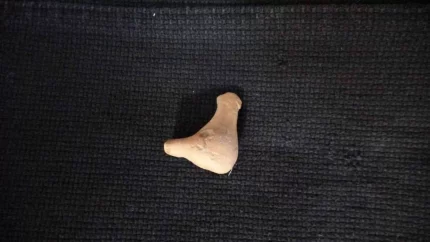 A tiny Roman-era terracotta whistle that was likely a cherished good left in a child’s grave has been discovered in a in the ancient Aegean coastal resort town of Assos in northwestern Turkey. The whistle is shaped like a stylized bird and is in excellent condition. It still whistles!
A tiny Roman-era terracotta whistle that was likely a cherished good left in a child’s grave has been discovered in a in the ancient Aegean coastal resort town of Assos in northwestern Turkey. The whistle is shaped like a stylized bird and is in excellent condition. It still whistles!
There is evidence of settlement on the hilltop overlooking the Aegean going back 7,000 years. The city of Assos was founded by Greek colonists in around 1000 B.C., Assos was a major artery of Aegean commerce for thousands of years and home to Aristotle’s first school of philosophy. The main civic structures — the agora, bouleuterion and theater — were built around 300 B.C.
 The whistle was unearthed in this season’s excavation focusing on the Hellenistic-era agora and gymnasium and the Byzantine-era Ayazma Church. The church was built in the 11th century over the ruins of a 6th century church believed to have been dedicated to an unknown saint buried there in the 5th century. By the time the saint was laid to rest there, the site had seen many a burial. A necropolis at the site had been in use since the Hellenistic era. One of the ancient burials is thought to be the source of the little whistle.
The whistle was unearthed in this season’s excavation focusing on the Hellenistic-era agora and gymnasium and the Byzantine-era Ayazma Church. The church was built in the 11th century over the ruins of a 6th century church believed to have been dedicated to an unknown saint buried there in the 5th century. By the time the saint was laid to rest there, the site had seen many a burial. A necropolis at the site had been in use since the Hellenistic era. One of the ancient burials is thought to be the source of the little whistle.
In the examination made by the excavation team, it was determined that the bird figure made of terracotta found on the surface around the Ayazma Church is believed to be the ruins from the Roman period or before, said Arslan. In addition, they seem to be causal children’s toys of the time and were placed in children’s graves as a cultural ritual. This particular Roman whistle is estimated to be 2,000 years old.
The estimate is based on its design and material. Unfortunately the context was disturbed which is why the whistle was found close to the surface. The grave the whistle may have been buried in has not been found.
